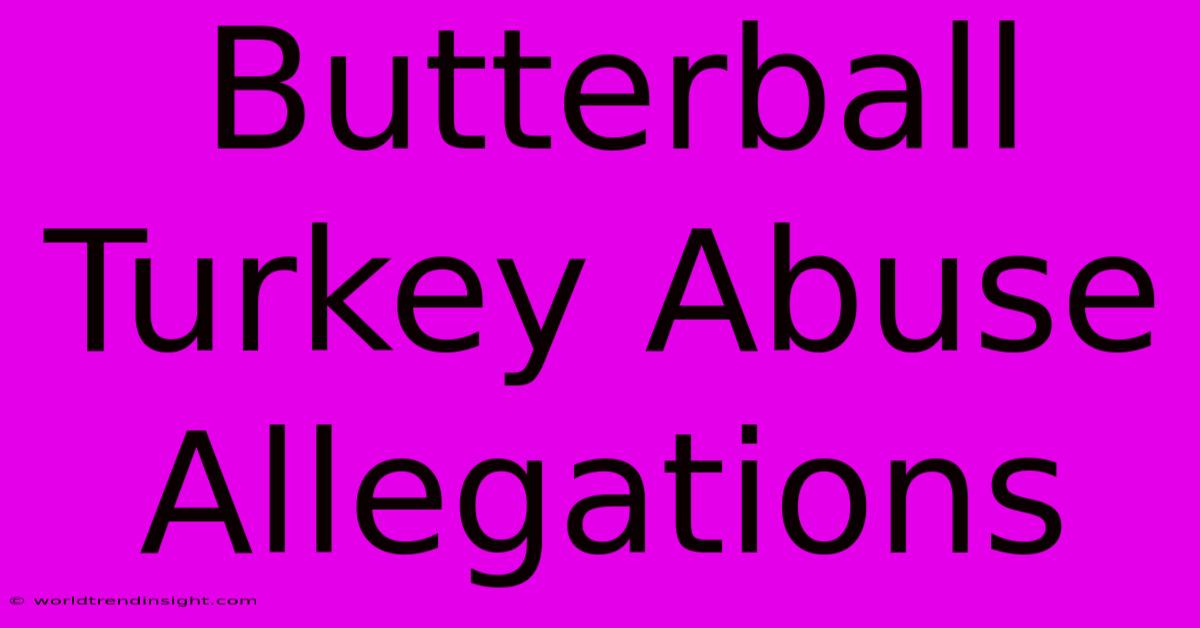Butterball Turkey Abuse Allegations

Discover more detailed and exciting information on our website. Click the link below to start your adventure: Visit Best Website Butterball Turkey Abuse Allegations. Don't miss out!
Table of Contents
Butterball Turkey Abuse Allegations: Separating Fact from Fiction
Hey everyone, let's talk about something that's been making the rounds – the Butterball turkey abuse allegations. I know, it's a bit of a bummer to think about, especially around the holidays when we're all feeling cozy and thankful. But it's important to look at these claims critically and figure out what's actually going on. I mean, who wants to eat a turkey that's been, ahem, mistreated? Not me!
My First Thanksgiving Disaster (and what I learned about ethical sourcing)
My first Thanksgiving cooking attempt was… a disaster. I was young, and overly confident. I thought I could totally handle a 20-pound Butterball turkey all by myself. Spoiler alert: I couldn't. Not only did the bird end up looking more like a deflated football, but I also felt terrible afterward. I hadn't really thought about where my turkey came from – I just grabbed the biggest one off the shelf. That experience taught me a valuable lesson: knowing your food source is key, even if it's more complicated than just grabbing the biggest, cheapest bird.
What are the Allegations?
So, what are these Butterball turkey abuse allegations all about? Well, various animal welfare organizations have raised concerns about the treatment of turkeys on farms that supply Butterball. The claims usually revolve around issues like overcrowding, inadequate access to food and water, and improper handling that causes stress and injury. It's pretty grim stuff if true.
Separating Sensationalism from Substance
It's crucial to remember that many of these accusations come from activist groups, and we need to approach these claims with a healthy dose of skepticism. Sometimes, information gets exaggerated or misrepresented in the process of creating buzz. However, that doesn't mean we should completely dismiss the allegations. Reputable organizations like the Humane Society of the United States (HSUS) do conduct thorough investigations, and their findings should be carefully considered. Their reports often include detailed accounts and photographic evidence. We can't just ignore what they're reporting.
What Can We Do?
So, what can we, as consumers, do? We’re not helpless bystanders here. Here's what I've found works:
- Look for labels: Some brands are certified by organizations like the Certified Humane program or Global Animal Partnership. These labels offer some assurance that the animals were raised with higher welfare standards. It’s not a perfect system, but it’s a start.
- Support ethical brands: If you have a choice, favor companies with strong animal welfare policies. This sends a message to the industry that we care about humane treatment.
- Contact Butterball (and other companies): Don't be afraid to reach out to Butterball directly and express your concerns about these allegations. Remember: voicing your opinion is a super powerful tool. A large company is more likely to address these issues if they see many consumers caring about ethical sourcing.
- Read reviews carefully: Before buying, read reviews from multiple sources. Look for patterns of comments related to animal welfare. Sometimes, independent reviews paint a clearer picture than what a company advertises.
- Consider alternative proteins: If the whole thing feels too much, it’s okay to explore other options. Tofu roasts, anyone? There are plenty of delicious alternatives to turkey.
Remember folks, informed consumers can make a difference. By being aware of these issues and making conscious choices, we can encourage better practices within the food industry. Let's continue to discuss and demand transparency from food producers. This isn't just about a holiday meal, it’s about ethical food systems and how we can make them better. We've got this!

Thank you for visiting our website wich cover about Butterball Turkey Abuse Allegations. We hope the information provided has been useful to you. Feel free to contact us if you have any questions or need further assistance. See you next time and dont miss to bookmark.
Featured Posts
-
Chelsea Man Utd Chase 67m Star
Nov 27, 2024
-
Itv This Morning Bonnie Blues Actions
Nov 27, 2024
-
Mc Donald Dizzying Taoisigh Rotation
Nov 27, 2024
-
13 Year Old Ipl Player Faces Age
Nov 27, 2024
-
Live Manchester City Vs Feyenoord
Nov 27, 2024
